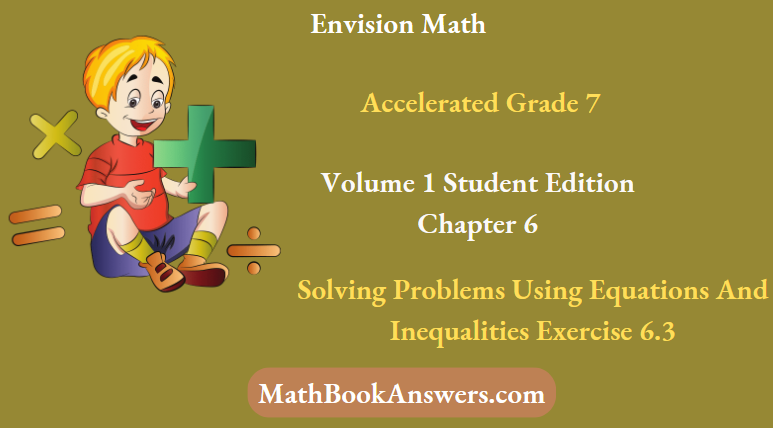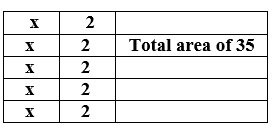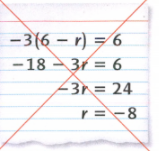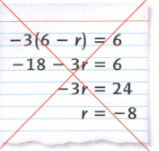Envision Math Accelerated Grade 7 Volume 1 Chapter 6 Solving Problems Using Equations And Inequalities
Question. Six friends go white-water rafting. The total cost for the adventure is $683.88, including a $12 fee per person to rent flotation vests. Marcella says they can use the equation 6r + 12 = 683.88 to find the rafting cost, r, per person, Julia says they need to use the equation 6(r + 12) = 683.88.
Given:
Six friends go white-water rafting.
The total cost for the adventure is $683.88, including a $12 fee per person to rent flotation vests.
Marcella says they can use the equation 6r + 12 = 683.88 to find the rafting cost, r, per person, Julia says they need to use the equation 6 (r + 12) = 683.88
To find/solve
Question. Whose equation accurately represents the situation? Construct an argument to support your response.
The distributive property tells us how to solve expressions in the form of a (b + c).
The distributive property is sometimes called the distributive law of multiplication and division.
The equation given by Julia shows the correct representation of the situation.
In her equation she showed that the $12 fee for the flotation vests rental must be adequately distributed to the number of persons who will be using it.
Julia has an accurate representation of the equation.
Given:
Six friends go white-water rafting.
The total cost for the adventure is $683.88, including a $12 fee per person to rent flotation vests.
Marcella says they can use the equation 6r +12=683.88 to find the rafting cost, r, per person, Julia says they need to use the equation 6(r+12) = 683.88

To find/solve
Question. What error in thinking might explain the inaccurate equation?
In the first equation, it shows that the flotation vests rental is added to the rafting cost of all six friends.
Marcella may have thought that the $12 flotation vests fee is for all and not per person.
Marcella might be thinking that the flotation vest rental fee covers the whole group as one and not individually.
Question. How does the Distributive Property help you solve equations?
Solving equations using distributive property involves the quantities and variables found in the given situation.
It will enable to make difficult problems easier by breaking down the factor as a difference of two numbers which indicates the quantities stated in the problem.
Distributive property helps solve equations by multiplying the two terms in the parenthesis by the term outside the parenthesis.
Envision Math Accelerated Grade 7 Chapter 6 Exercise 6.3 Answer Key
Question. Can the equation 32x + 2.32 = 114.24 be used to find the original cost of each figurine in the problem above.
Given:
Can the equation 32x + 2.32 = 114.24 be used to find the original cost of each figurine in the problem above.
To find/solve
Explain.
− \(\frac{1}{2}b\) +\( \frac{6}{2}\) = 5
− \(\frac{1}{2}b\) + 3 = 5
− \(\frac{1}{2}b\) − 3 + 3 = 5−3
− \(\frac{1}{2}b\) =2
− 2 (\(\frac{-1}{2}b\)) = (2) − 2
b = −4
0.4x − 0.18 = 9.2
0.4x = 9.2 + 0.18
x = 23.45
−4p = 848 = 44
-4p = 44−848
−4p = −804
P = 201
Solution
1) B = −4
2) X = 23.45
3) P = 201
Question. How does the Distributive Property help you solve equations?
Given:
To find/solve
How does the Distributive Property help you solve equations?
Solving equations using distributive property involves the quantities and variables found in the given situation.
It will enable to make difficult problems easier by breaking down the factor as a difference of two numbers which indicates the quantities stated in the problem.
Distributive property helps solve equations by multiplying the two terms in the parenthesis by the term outside the parenthesis.
Question. How are the terms in parentheses affected when multiplied by a negative coefficient when the Distributive Property is applied?
Given
Statement
To find/solve
How are the terms in parentheses affected when multiplied by a negative coefficient when the Distributive Property is applied?
The terms inside the parenthesis are affected if a negative coefficient is multiplied using the distributive property.
If the terms inside the parenthesis are negative then the product will be positive and if the terms inside the parenthesis are positive the product will be negative.
The signs will be changed if the number outside has a negative coefficient.
Signs inside the parenthesis will be changed if the term outside has a negative coefficient.
Question. How can an area model help you set up an equation for a problem situation?
Given
Statement
To find/solve
How can an area model help you set up an equation for a problem situation?
Using an area model can easily visualize how to represent an equation for a given problem.
5 (x + 2) = 35

It can easily visualize the quantities involved in the problem.
Envision Math Grade 7 Chapter 6 Solving Equations And Inequalities Exercise 6.3 Solutions
Question. A family of 7 bought tickets to the circus. Each family member also bought a souvenir that cost $6. Total amount they spent was $147. How much did one ticket cost?
Given:
A family of 7 bought tickets to the circus.
Each family member also bought a souvenir that cost $6.
The total amount they spent was $147
To find/solve
How much did one ticket cost?
Determine the amount of one ticket
7(x + 6) = 147
7x + 42 = 147
7x + 42 − 42 = 147 − 42
7x = 105
x = 15
One ticket costs $15.
Question. David says that the original price of the shorts was $41. Does his answer seem reasonable? Defend your answer by writing and solving an equation that represents the situation.
Given:
David says that the original price of the shorts was $41.
To find/solve
Does his answer seem reasonable? Defend your answer by writing and solving an equation that represents the situation.
David did not get the correct original price of the shorts and the price is not reasonable.
The correct equation that represents the situation is
1/4 (x + 18) = 10.25
1/4x + 18/4 = 10.25
1/4x + 4.5 = 10.25
1/4x = 5.75
x = 23
The original price of the shorts is $23.
Solving Problems Using Equations And Inequalities Grade 7 Exercise 6.3 Envision Math
Question. Which of the following shows the correct use of the Distributive Property when solving \(\frac{1}{3}\)(33 – x) = 135.2 the equation.
We need to find which of the following shows the correct use of the Distributive Property when solving \(\frac{1}{3}\)(33-x) = 135.2
The given expression is \(\frac{1}{3}\)(33 − x) = 135.2
Using the distributive property, the expression becomes
\(\frac{1}{3}\)(33 − x) = 135.2
\(\frac{1}{3}\)×33 − \(\frac{1}{3}\)x = 135.2
\(\frac{1}{3}\).33 − \(\frac{1}{3}\).x = 135.2
The correct use of the given expression using the distributive property will be (D) 1
\(\frac{1}{3}\).33-\(\frac{1}{3}\).x = 135.2
Question. Use the Distributive Property to solve \(\frac{1}{8}\)(p + 24) = 9 equation.
We need to use the Distributive Property to solve the given equation.
The given equation is \(\frac{1}{8}\)(p + 24) = 9
The given expression is \(\frac{1}{8}\)(p+24) = 9
Using the distributive property, we get
\(\frac{1}{8}\)(p + 24) = 9
\(\frac{p}{8}\) + \(\frac{24}{8}\)= 9
\(\frac{p}{8}\)+3 = 9
\(\frac{p}{8}\) = 9−3
\(\frac{p}{8}\) = 6
p = 6 × 8
p = 48
The value of p=48
Question. Use the Distributive Property to solve the \(\frac{2}{3}(6a+9)\) = 20.4 equation.
We need to use the Distributive Property to solve the given equation.
The given equation is \(\frac{2}{3}(6a+9)\) = 20.4
The given expression is \(\frac{2}{3}(6a+9)\) = 20.4
Using the distributive property, we get
\(\frac{2}{3} {6a+9}\) = 20.4
\(\frac{2}{3}\) × 6a + \(\frac{2}{3}\)×9 = 20.4
2 × 2a + 2 × 3 = 20.4
4a + 6 = 20.4
4a + 6 = 20.4
4a = 20.4 − 6
4a = 14.4
a = \(\frac{14.4}{4}\)
a = 3.6
The value of a = 3.6
Given:
If you apply the Distributive property first to solve the equation, what operation will you need to use last?
To find/solve
Using the distributive property.
6 \(\frac{d}{3}\) − 30 = 34
2d−30 = 34
2d = 64
d = 32
When a distributive property is used as the first step to solve the equation, the last operation will be division.
Given:
If instead, you divide first to solve the equation, what operation would you need to use last?
To find/solve
Using the distributive property.
\(\frac{6 \frac{d}{3}-5}{6}=\frac{34}{6}\) \(\frac{d}{3}-5=\frac{34}{6}\)d = \(\frac{192}{6}\)
d = 32
When a distributive property is used as the first step to solve the equation, the last operation will be division.
Envision Math Grade 7 Exercise 6.3 Solution Guide
Question. A local charity receives \(\frac{1}{3}\) of funds raised during a craft fair and a bake sale. The total amount given to charity was $137.45. How much did the bake sale raise?
Given:
A local charity receives \(\frac{1}{3}\) of funds raised during a craft fair and a bake sale.
The total amount given to charity was $137.45.
To find/solve
How much did the bake sale raise?
Determine the amount raised by the bake sale.
\(\frac{1}{3}(x+252.60)=137.45\) \(\frac{1}{3} x+84.20=137.45\) \(\frac{1}{3} x=53.25\)x = 159.75
The amount raised by the bake sale is $159.75.
Question. Diagram shown for the equation is incorrect. Find the correct solution.
Given that, the solution shown for the equation is incorrect.
We need to find the correct solution.

The given equation is − 3(6 − r) = 6
Solving the given using the distributive property, we get
-3(6-r) = 6
-18 + 3r = 6
-18 + 18 + 3r = 6 + 18
3r = 24
r = \(\frac{24}{3}\)
r = 8
The value of r = 8 not r = −8
The multiplication of two negative integers result in a positive product.
Given that, the solution shown for the equation is incorrect.
We need to find the error made.

The given equation is − 3(6 − r) = 6
Solving the given using the distributive property, we get
− 3(6 − r) = 6
− 18 + 3r = 6
3r = 24
r = \(\frac{24}{3}\)
r = 8
The multiplication of two negative integers results in a positive product. The multiplication of two negative integers results in a positive product. Here, he has multiplied two negative integers and put the result as negative. This was likely the error he made.
Question. Vita wants to center a towel bar on her door that is \(27\frac{1}{2}\) inches wide. She determines that the distance from each end of the towel bar to the end of the door is 9 inches.
Given:
Vita wants to center a towel bar on her door that is \(27\frac{1}{2}\)inches wide.
She determines that the distance from each end of the towel bar to the end of the door is 9 inches.
Let x inches be the length of the towel bar.
The width of the door is 9 inches on each side of the towel bar.
So the width of the door is
9 + x + 9 = x + 18inches
It’s given that the width of the door is \(27\frac{1}{2}\)
∴ \(27\frac{1}{2}\) = 18 +x
Now we solve the equation:
\(27\frac{1}{2}\) = 18 + x
\(27\frac{1}{2}\) − 18 = 18 + x − 18 ( Subtract −18 on both sides)
x = 9\(\frac{1}{2}\)
x = 4.5
Therefore, the length of the towel bar is x = 4.5
Envision Math Accelerated Grade 7 Chapter 6 Exercise 6.3 Answers
Question. Apply the properties of equality to isolate the variable.
We need to explain how to isolate the variable in the equation \(\frac{-2}{3}n+7\) = 15
Apply the properties of equality to isolate the variable.
\(\frac{-2}{3}n+7\)− 7 = 15−7
\(\frac{-2}{3}n\) = 8
\(\frac{-3}{2}n\)×\(\frac{-2}{3}n\)
= 8 × \(\frac{-2}{3}n\)
n =− 12
Use the properties of equality to isolate the variable in the equation to get the solution of
n =−12
Use the properties of equality to isolate the variable in the equation to get the solution of n =−12.
Question. Find the equations which are equivalent to \(\frac{1}{2}\)(4+8x) = 17.
We need to find the equations which are equivalent to
\(\frac{1}{2}\)(4+8x) = 17
Determine the equation similar to the given
\(\frac{4}{2}\) + \(\frac{8}{2}\)x = 17
2 + 4x = 17
4x = 15
x = \(\frac{15}{4}\)
Determine the equation similar to the given
\(\frac{4+8 x}{2}\) = 17
2.(\(\frac{4+8 x}{2}\)) = 17.2
4 + 8x = 34
8x = 30
x = \(\frac{30}{8}\)
The similar equations are 4 + 8x = 34 and 4x = 15.
Question. Clara has 9 pounds of apples. She needs 11/4 pounds to make one apple pie. If she sets aside 1.5 pounds of apples. How many apple pies clara makes.
Given:
Clara has 9 pounds of apples. She needs 11/4 pounds to make one apple pie. If she sets aside 1.5 pounds of apples.
The equation for the given situation is 1\(\frac{1}{4}\)p = 9-1.5
1\(\frac{1}{4}\)p = 9 −1.5
\(\frac{5}{4p}\) = 7.5
5p = 4(7.5)
5p = 30
p = 6
Clara can make 6 apple pies.
Question. Solve the given equation -4(1.75 + x) = 18
Given:
− 4 (1.75 + x) = 18
we have to solve the given equation.
First, we will apply distributive property and apply other properties of equality.
Given equation is − 4(1.75 + x) = 18
7 − 4x = 18 (Distributive property)
− 7− 4x + 7 = 18 + 7 (Adding 7 to both sides)
−4x = 25
\(\frac{-4x}{-4}\)=\(\frac{25}{-4}\) (Dividing both sides by− 4)
x = −6.25
The value of x is − 6.25
Envision Math 7th Grade Exercise 6.3 Step-By-Step Solutions
Question. A group of 4 friends travel in a train ticket cost for one person $6 and total amount they spent by 4 friends is $34 they buy a healthy snack bag find the value of healthy snack bag. write the equation which represents the total amount spent and then we will solve it.
Given:
Ticket cost for one person = $6
Cost of healthy snack bag = $b
The total amount spent by 4 friends is $34
We have to find the value of b.
First, we will write the equation which represents the total amount spent and then we will solve it.
Given:
Ticket cost for one person = $6
Cost of healthy snack bag = $b
The total amount spent by 4 friends is $34
Therefore,
Amount spent by one friend = 6 + b
Total amount spent by 4 friends = 4(6 + b) = 34
4 (6 + b) = 34
24 + 4b = 34 (Distributive property)
24 + 4b −24 = 34 − 24 (Subtracting 24 from both sides)
4b = 10
\(\frac{4b}{4}\)=\(\frac{10}{4}\) (Dividing both sides by 4)
b = 2.5
Hence, the cost of a healthy snack bag is $2.50
Equation is 4(6 + b) = 34
The cost of a healthy snack bag is $2.50.
